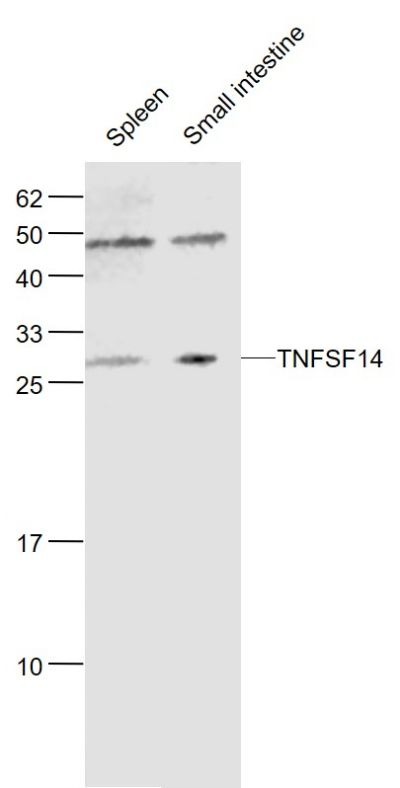Shopping Cart
Remove All Your shopping cart is currently empty
Your shopping cart is currently empty
Anti-LIGHT/TNFSF14 Polyclonal Antibody is a Rabbit antibody targeting LIGHT/TNFSF14. Anti-LIGHT/TNFSF14 Polyclonal Antibody can be used in ELISA,WB.
| Pack Size | Price | USA Warehouse | Global Warehouse | Quantity |
|---|---|---|---|---|
| 50 μL | $220 | 7-10 days | 7-10 days | |
| 100 μL | $372 | 7-10 days | 7-10 days | |
| 200 μL | $528 | 7-10 days | 7-10 days |
| Description | Anti-LIGHT/TNFSF14 Polyclonal Antibody is a Rabbit antibody targeting LIGHT/TNFSF14. Anti-LIGHT/TNFSF14 Polyclonal Antibody can be used in ELISA,WB. |
| Synonyms | tumor necrosis factor (ligand) superfamily, member 14, TR2, LTg, LIGHT, HVEML, CD258 |
| Ig Type | IgG |
| Reactivity | Human,Mouse (predicted:Rat) |
| Verified Activity | Sample: Spleen (Mouse) Lysate at 40 μg Small intestine (Mouse) Lysate at 40 μg Primary: Anti-TNFSF14 (TMAB-01068) at 1/1000 dilution Secondary: IRDye800CW Goat Anti-Rabbit IgG at 1/20000 dilution Predicted band size: 26 kDa Observed band size: 26 kDa  |
| Application | |
| Recommended Dose | WB: 1:500-2000; ELISA: 1:500-5000 |
| Antibody Type | Polyclonal |
| Host Species | Rabbit |
| Subcellular Localization | Tumor necrosis factor ligand superfamily member 14, membrane form: Cell membrane; Single-pass type II membrane protein.Tumor necrosis factor ligand superfamily member 14, soluble form: Secreted.Isoform 2: Cytoplasm. |
| Tissue Specificity | Predominantly expressed in the spleen but also found in the brain. Weakly expressed in peripheral lymphoid tissues and in heart, placenta, liver, lung, appendix, and kidney, and no expression seen in fetal tissues, endocrine glands, or nonhematopoietic tu |
| Construction | Polyclonal Antibody |
| Purification | Protein A purified |
| Appearance | Liquid |
| Formulation | 0.01M TBS (pH7.4) with 1% BSA, 0.02% Proclin300 and 50% Glycerol. |
| Concentration | 1 mg/mL |
| Research Background | LIGHT protein is a type II transmembrane protein and a tumor necrosis factor (TNF) ligand superfamily member (TNFSF14). LIGHT is expressed on activated T cells and immature dendritic cells and its receptors have been identified as lymphotoxin-Beta receptor (LTBetaR) and the herpesvirus entry mediator (HVEM), both of which lack the cytoplasmic sequence termed as "death domain." LIGHT is first identified as HVEM ligand (HVEM-L) and a deterrent to herpesvirus infection according to its ability to compete with HSV glycoprotein D for HVEM binding. As a T cell-derived costimulatory ligand, TNFSF14 plays a crucial role in T cell activation and proliferation by LIGHT-LTBetaR interaction, and it is necessary and sufficient for LIGHT-mediated apoptosis of tumor cells. Additionally, recent studies also establish a direct role for LIGHT in NK activation/expansion via LIGHT-HVEM interaction, and thus breaking T-cell tolerance at the tumor site. Accordingly, LIGHT is suggested to be involved in CTL-mediated tumor rejection, allograft rejection and graft versus host disease. Although known as lymphotoxin-Gamma, LIGHT plays a minimal role in lymphoid tissue development in contrast with LT-Alpha and Beta. This protein was also demonstrated to inhibit TNF-Alpha-mediated but not Fas- or TRAIL-mediated apoptosis of human primary hepatocytes. |
| Immunogen | KLH conjugated synthetic peptide: human TNFSF14 |
| Antigen Species | Human |
| Gene Name | TNFSF14 |
| Gene ID | |
| Protein Name | Tumor necrosis factor ligand superfamily member 14 |
| Uniprot ID | |
| Function | Cytokine that binds to TNFRSF3/LTBR. Binding to the decoy receptor TNFRSF6B modulates its effects. Activates NFKB, stimulates the proliferation of T-cells, and inhibits growth of the adenocarcinoma HT-29. Acts as a receptor for Herpes simplex virus. |
| Molecular Weight | Theoretical: 26 kDa. |
| Stability & Storage | Store at -20°C or -80°C for 12 months. Avoid repeated freeze-thaw cycles. |
| Transport | Shipping with blue ice. |
| Size | Quantity | Unit Price | Amount | Operation |
|---|

Copyright © 2015-2025 TargetMol Chemicals Inc. All Rights Reserved.